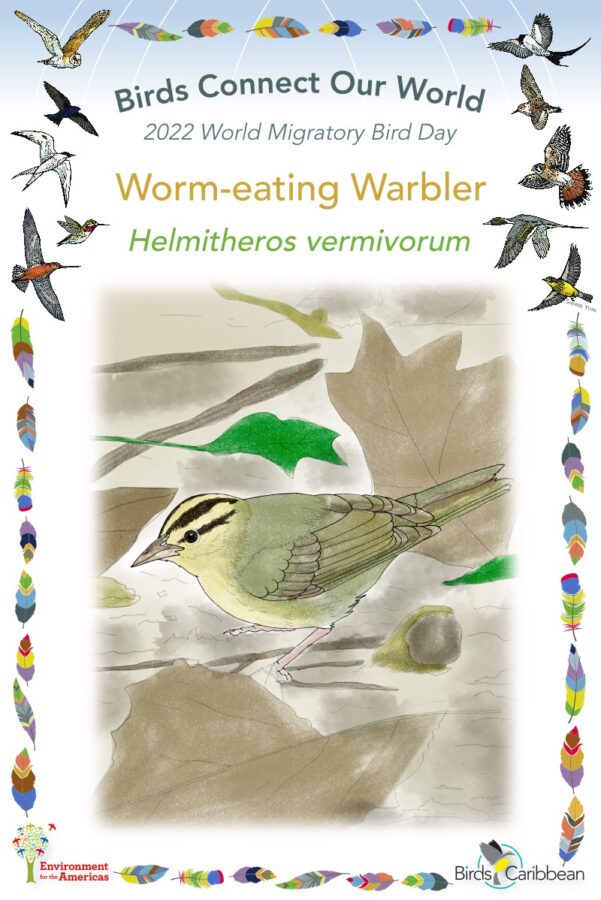Celebrate World Migratory Bird Day (WMBD) with us in 2022! This year’s theme is “Dim The Lights for Birds at Night”. Have fun learning about a new migratory bird every day. We have colouring pages, puzzles, activities, and more. Download for free and enjoy nature with your family at home.
Migratory Bird of the Day: Worm-eating Warbler
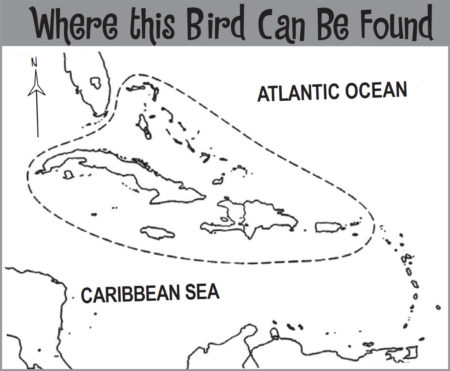 The early birder sees the Worm-eating Warbler! On first appearance these drab warblers appear similar to the skulky Swainson’s Warbler we featured earlier, but be sure to check out their face. Worm-eating Warbler has a black stripe through the eye and another black stripe above the eye, whereas Swainson’s Warbler has more of rusty line through the eye and rusty-brown cap. Worm-Eating Warblers have a buffy-tan colored head and more olive colored body compared to the warm brown tones of the Swainson’s Warbler.
The early birder sees the Worm-eating Warbler! On first appearance these drab warblers appear similar to the skulky Swainson’s Warbler we featured earlier, but be sure to check out their face. Worm-eating Warbler has a black stripe through the eye and another black stripe above the eye, whereas Swainson’s Warbler has more of rusty line through the eye and rusty-brown cap. Worm-Eating Warblers have a buffy-tan colored head and more olive colored body compared to the warm brown tones of the Swainson’s Warbler.
They are well known for their habit of hopping through the understory and probing dead leaves, a technique they employ both on their breeding and wintering grounds. Their favorite food is caterpillars which is what earned them their “worm-eating” name.
Within the Caribbean they can mainly be found overwintering in the Bahamas, The Cayman Islands, and the Greater Antilles, including Cuba, Jamaica, Dominican Republic, and Puerto Rico. They have been recorded occasionally on several other islands throughout the region including Guadeloupe, Turks and Caicos, the British Virgin Islands, Barbados and Curacao. So be sure to be on the lookout this fall! They don’t overwinter exclusively in the Caribbean however, as part of the population will overwinter in Southern Mexico and Central America.
Like many other migratory birds, Worm-eating Warblers choose to migrate at night, giving us another reason to turn the lights off during high volume migration periods. They appear to travel long distances when they are on the move, and it seems they have a preference to hug the Mexican coastline down rather than crossing the Gulf of Mexico. The majority of the data about these birds on both their overwintering grounds and migration stopover comes from Mexico and Central America. There is still more to understand about these birds during their overwintering/migration in the Caribbean.
Be on the lookout for Worm-eating Warblers in forest and scrub habitats in the Greater Antilles. Like other drabber warblers, they tend to be more skulky, hiding in the dense understory. Similar to many other migratory birds, these warblers are suffering from habitat loss, especially on their overwintering grounds, though more study is needed. Have you seen a Worm-eating Warbler on your island? Learn more about this species, including its range, photos, and calls here.
Colour in the Worm-eating Warbler
Download the Migratory Birds of the Day Colouring Page! Use the picture above and the photos on this page as your guide, or you can look up pictures of the bird online or in a bird field guide if you have one. Share your coloured-in page with us by posting it online and tagging us @BirdsCaribbean #WMBD2022Carib
Listen to the calls of the Worm-eating Warbler
The calls of the Worm-eating Warbler are a load “chip, chip, chip“
Puzzles of the Day
Click on the images below to do the puzzle. You can make the puzzle as easy or as hard as you like – for example, 6, 8, or 12 pieces for young children, all the way up to 1,024 pieces for those that are up for a challenge!
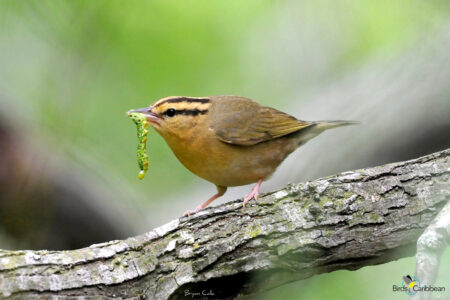
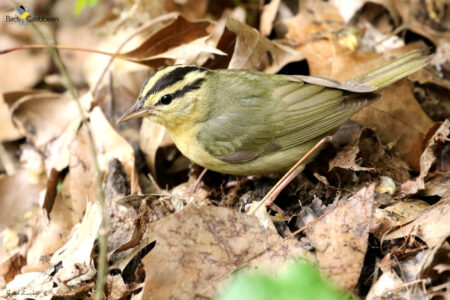
Activity of the Day
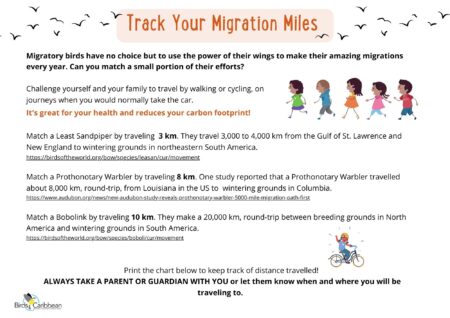 FOR KIDS: Many of the ‘migratory birds of the day’ we’ve met so far make amazing journeys during fall, coming to the Caribbean to rest and refuel or to spend the winter with us. Some of our migratory birds are short and medium distance migrants, like the Black-crowned Night-heron. Perhaps traveling several 100km from their breeding areas to their wintering grounds. Others, like the Worm-eating Warbler are long-distance migrants and might travel 1000s of km during their migratory journeys! Why not try to ‘match’ some of our amazing long distance migrants by taking part in our Tracking Your Migration Miles activity. In this activity we are challenging you to switch some of your journeys from using the car to ‘active travel’ (waking, cycling etc.) to cut your carbon footprint. Don’t worry we are not asking you to run 3,000km, like a Least Sandpiper’s migratory journey! We’ve scaled down our distances (from 3-10km) to make it a fun activity everyone can take part in! Track you progress on our recording sheet here.
FOR KIDS: Many of the ‘migratory birds of the day’ we’ve met so far make amazing journeys during fall, coming to the Caribbean to rest and refuel or to spend the winter with us. Some of our migratory birds are short and medium distance migrants, like the Black-crowned Night-heron. Perhaps traveling several 100km from their breeding areas to their wintering grounds. Others, like the Worm-eating Warbler are long-distance migrants and might travel 1000s of km during their migratory journeys! Why not try to ‘match’ some of our amazing long distance migrants by taking part in our Tracking Your Migration Miles activity. In this activity we are challenging you to switch some of your journeys from using the car to ‘active travel’ (waking, cycling etc.) to cut your carbon footprint. Don’t worry we are not asking you to run 3,000km, like a Least Sandpiper’s migratory journey! We’ve scaled down our distances (from 3-10km) to make it a fun activity everyone can take part in! Track you progress on our recording sheet here.
FOR KIDS AND ADULTS: Enjoy this video of a Worm-eating Warbler

